Anton Stadler was a clarinet virtuoso of Vienna and close friend of Mozart (Fig. 1).1
Figure 1. Silhouette of Anton Stadler. Courtesy of the Deutsche Staatsbibliothek, East Berlin.
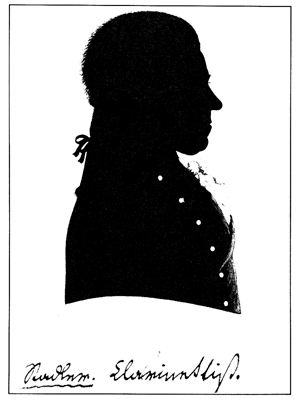
Stadler and Theodor Lotz (who was Royal Instrument Maker to the Viennese court) extended the range of the clarinet down to small c and added key work for the pitches e-flat, d, c-sharp, and c. These pitches will be called basset notes throughout this article. At the time the instrument was known as a bass clarinet, basset clarinet, or simply as "a newly-invented clarinet." Today it is usually called a basset clarinet. As evidenced by musical examples and journals of the time, the basset clarinet was made in the keys of B-flat, A, and C.2 Recent research by Ernst Hess and Jiri Kratochvil has shown that Mozart's Concerto in A Major, K. 622 was written for Stadler's basset clarinet, thereby attesting to the importance of both the instrument and the inventors.3 The basset horn was a member of the clarinet family, invented during the 1770s, and pitched in F or G. The basset horn's shape varied from that of a sickle to a right or obtuse angle. The improvement Lotz made was to extend the lower range of the basset horn to small c.
According to records recently found by Karl Maria Pisarowitz, Anton Paul Stadler was born on June 28, 1753 at Bruck an der Leitha, outside Vienna. Three years later his family moved to Vienna, where his brother Johann was born. The musical training of Anton and Johann was probably supervised by their father Joseph Stadler, who was a musician and shoemaker.4 Musical dictionaries of the eighteenth century report that the brothers played clarinet and basset horn. The Journal des Luxus und der Moden of 1801 includes a description of Anton as "a great artist on many wind instruments."5 In a letter to Ignatz von Beecke dated November 1781, Anton writes that he and his brother "can also play a little violin and viol [sic]."6
The Stadler brothers' performing career in Vienna began as early as 1773, when they appeared in a concert on March 21 at the Ktnertortheater.7 Until 1782 Anton and Johann held various positions. According to the open account books of the imperial court of 1779 they were hired by the court on a per-service basis.8 A concert program of March 12, 1780 identifies the brothers as being in the service of Count Carl of Palm.9 As of October 1780 Anton was employed by the Piaristen religious order of Maria Treu as a "manorial musician."10 In 1781 Anton was in the service of Count Dimitri Galizin.11 In the same year Kaiser Joseph II designated their services as "indispensable."12 This designation was obviously not enough to contribute to their financial and artistic security, because on November 6, 1781 one of the Stadlers wrote a letter to Ignatz von Beecke of the Wallerstein orchestra seeking employment for himself, his brother and a fellow bassoonist named Griesbacher. Dr. Volker von Volckamer, archivist of the Wallerstein'sche Bibliothek und Kunstsammlung, has informed me that none of the three ever secured employment there (Fig. 2).13
Figure 2a. Address & first page.
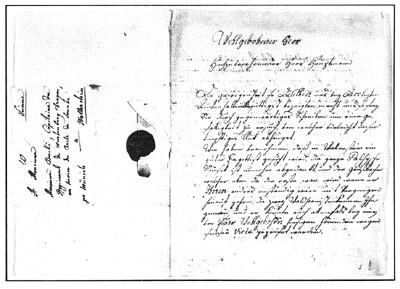
Figure 2b. Second page.
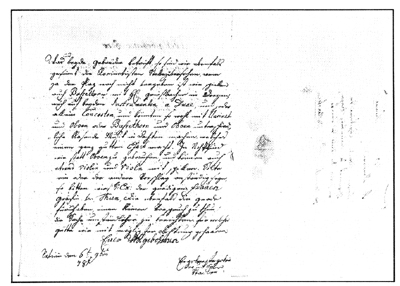
Finally, on February 8, 1782 the brothers were invited to join the orchestra of the imperial court in Vienna. The imperial report read as follows, "The two brothers Stadler who play clarinet are appointed to the orchestra because they are often needed and they might travel or go into service elsewhere."14 According to Gerber's Lexikon of 1792 the brothers were members of the Kaiser's wind octet, called Harmonie, in 1783. Reportedly Anton played second clarinet. Stadler's interest in extending the chalumeau register of the clarinet may be traced to his playing second clarinet in the Harmonie. The treatment of the clarinet at the time was similar to that of the French horn; the second part was written for the lower range of the clarinet. The brothers' positions were reversed for the court orchestra, however, with Anton assuming the first chair.15
It is not known exactly when Mozart and Stadler first met and became friends. Mozart moved to Vienna in March 1781. Mozart composed basset horn music, which may have been inspired by Stadler, as early as 1783. According to Otto Deutsch in his Mozart Documentary, the first performance by Stadler of a Mozart work took place on March 23, 1784 in the first performance of the Serenade in B-flat for 13 instruments, K. 361.16 It is possible that the two had met earlier than this date. In a letter to his father in October, 1781, Mozart mentions a clarinetist who took part in the first performance of the Serenade in E-flat, K. 375 for pairs of clarinets, horns and bassoons. "The six gentlemen who executed it are poor beggars, who however, play quite well together, particularly the first clarinet and two horns."17 By all accounts the description would have fitted Stadler, who was a good musician and probably quite poor.
Mozart, Stadler and Theodor Lotz were all members of the Palm Tree Masonic Lodge in 1785. Lotz played first clarinet and viola at the court of the Fürstbischof in Pressburg, and there made improvements to the basset horn in 1782. In 1788 he was appointed as Royal Instrument Maker to the Kaiser in Vienna. A basset horn and a clarinet of his manufacture survive today.18
The earliest mention of the basset clarinet appears in the program of a concert given at the Royal and Imperial Theater in Vienna on February 20, 1788 (Fig. 3).
Figure 3.
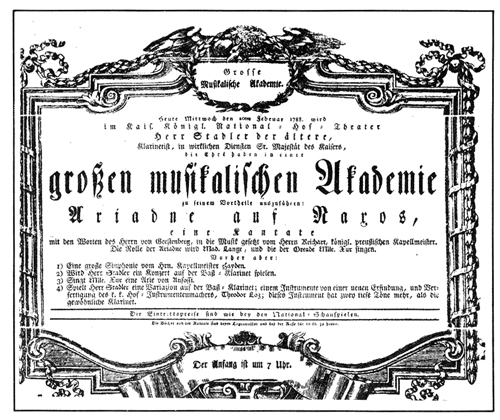
"Herr Stadler the elder, in the service of His Majesty the Kaiser, will play a concerto on the Bass-Klarinet and a variation on the Bass-Klarinet, an instrument of new invention and manufacture of the Royal and Imperial Instrument Maker, Theodor Loz [sic]. This instrument has two more low tones than the normal clarinet."19 The added notes may have been d and c or e-flat and d. Small d and c would enable the performer to complete the lower pitches of C Major, the clarinet's "favorite" key at that time.20 However, the musical evidence suggests that the pitches were e-flat and d. It is not known which concerto and variations were performed. The Mozart concerto was not completed until 1791. The compositions may have been written by Stadler. The Hofmeister-Whistling catalogs of 1817, 1828-29 and 1844-45 list a total of seven works for clarinet by Stadler which include Variations on Different Favorite Themes and ten variations on You Must Not Take Amiss With Me. The variations cited in the February program may have been one of these. The concerto has yet to be identified. Stadler may also have taken existing compositions and added notes where appropriate.
Mozart had already written for basset clarinet in B-flat a year earlier, in the spring of 1787. Ninety-three measures of an incomplete quintet movement for clarinet and strings, K. 516c, Anhang 91, survive in the Bibliothèque Nationale. The written pitch d or basset note d appears seven times. When writing for basset clarinet, Mozart refers to it in his scores, simply as clarinet. The basset notes are written in the bass clef in the great octave range, as are French horn parts. In 1970 Nagels-Verlag published a completed version of the fragment, composed by Robert Levin.21
A second quintet fragment by Mozart, K. 581a, Anhang 88, for the same combination was sketched in Vienna during September 1789.22 In the 102 measures Mozart wrote only once for the extended range: a single whole note e-flat. To be sure, the basset clarinet of 1787-89 had at least e-flat and d keys. This fragment is also interesting because of the use of soprano, alto, tenor, bass and treble clefs in the space of only 15 measures (measures 55-69).23 Mozart later used the melody from the fragment in aria 24 of Così fan tutte, which also makes use of basset clarinet.
Mozart wrote Così fan tutte during the last months of 1789. In the second clarinet part (in A-flat) of the autograph of the second act, aria 24 "Ah! lo veggio, quell'anima bella," sung by Ferrando, written small d is included a total of seven times (measures 43-51 and 75-79). These few measures are the only examples of basset note writing in the second act. The autograph score of the first act of Così (part of the Mendelssohn Archiv, Staatsbibliothek Preussische Kulturbesitz in West Berlin) was destroyed during World War II so it is impossible to determine if basset note writing occurs in the first act.24
Four keys are mentioned by Gerber in his Lexikon of 1792. ". . . the elder (Anton Stadler) . . . has, according to recent reports from Vienna, from the year 1790, lengthened his instrument a third in the low tones: so that he can, instead of having e as the lowest tone, play easily down to d-sharp, d, c-sharp and c." By 1790 the basset clarinet had four additional keys and was pitched in B-flat. Credit for the improvement has now been given to Stadler instead of Lotz, although Lotz may have added the first two keys and Stadler the remaining two. Stadler may also have taken credit when he could outside the city of Vienna, and certainly did so after Lotz's death in 1792.25
On September 6 and 30, 1791 Stadler played clarinet and basset horn in the Prague performances of La Clemenza di Tito. Mozart included two obbligato arias for each of these instruments.26 The first, aria 9, "Parto, parto ma tu ben mio," is for basset clarinet in B-flat. For the first time Mozart writes small c. The chromatic pitches are not used, only d and c. Mozart returned to Vienna after the first performance, which was not well received. Stadler presumably stayed on for the second performance at the end of the month. Mozart wrote to his wife after the second performance, "Cries of bravo were shouted at Stadler from the balcony and even from the orchestra."27
On October 7, 1791 Mozart wrote Constanze that he had "orchestrated almost the whole of Stadler's rondo." This most assuredly refers to the last movement of the clarinet concerto.28 In his book Mozart in Prag Rudolf Procházka wrote that according to Prague city records Stadler gave a concert there at the Royal Old City Theater on October 16, 1791.29 Georg Nikolaus von Nissen, the first biographer of Mozart, relates that Mozart "composed a concerto for clarinet in October, gave the composition to him [Stadler] and traveling money to Prague and made certain that he would make use of it [the concerto] there."30 This account suggests that Mozart made arrangements for the first performance of the concerto. Mozart gave Stadler the completed concerto on October 9 or 10. The trip would take four days (October 13 or 14) and the first performance of the concerto could have taken place on October 16. A program for that concert has not been located.
The autograph of Mozart's clarinet concerto is lost. However, the exposition of the first movement for a concerto for basset horn in G survives as part of the Rychenberg-Stiftung at Winterthur, Switzerland. Consisting of 199 measures, it is the same as the clarinet concerto except for being in the key of G and its use of basset notes. The fragment dates from the last few months of 1789. Ernst Hess found a curious key change in measure 180. Mozart suddenly changes the orchestral accompaniment from the key of the subdominant of G to the subdominant of A. The clarinet part remains the same. Time may have elapsed, because smaller and darker writing at that point also shows that Mozart changed to a new pen point. Evidently Mozart lost interest in the concerto in 1789. Interest was renewed in 1791 when he envisioned the concerto for basset clarinet. After measure 180 Mozart continues writing for basset notes and for the tonic key of A major. It seems that Mozart finished the concerto, now for clarinet in A, with basset notes. He probably rewrote the opening and gave it to Stadler along with the score that may have followed measure 199. It is very possible that Stadler lost the concerto during his concert tour of Europe between 1791 and 1795. The Prague performance was the beginning of that tour. Mozart's widow wrote to the music publisher André on May 31, 1800, "For information about other works of this kind you should apply to the elder Stadler, the clarinetist, who used to possess the original manuscripts of several, and has copies of some trios for basset horns that are still unknown. Stadler declares that while he was in Germany his portmanteau, with these pieces in it, was stolen. Others, however, assure me that the said portmanteau was pawned there for 73 ducats; but there were, I believe, instruments and other things in it as well."31
A reviewer for the Allgemeine musikalische Zeitung (March 1802) cites specific passages from all three movements of the clarinet concerto where unknown editors rewrote Mozart's music to suit the normal clarinet.
Finally, the critic feels obliged to say that Mozart wrote this concerto for a clarinet encompassing low c. Thus, the following passages in the principal voice have all to be transposed to the lower octave. . . . And in this way, very many places became transposed upwards and altered. . . . However, since clarinets encompassing c must at present be counted among the rarer instruments, thanks are due the editors for these transpositions and alterations, although they have not improved the concerto. Perhaps it would have been just as well to have published it in the original version and to have inserted these transpositions and alterations in smaller notes.32
An article in the Musikalisches Wochenblatt (January 1792) announced the arrival of Stadler in Berlin.
Mr. Stadeler [sic], clarinetist from Vienna. A man of great talent; he is also recognized for this [talent] at court, where he has been heard several times already. His playing is brilliant, and polished; he also has acquired a precision which shows his assuredness. But all in all, he does not have the ingratiating soft tone and taste for performance which Mr. Tausch, court musician with Her Majesty the Queen, so often delights his listeners. Mr. Stadler has also added several notes to his instrument by means of keys. However, the gain, through the added keys, is not very great, because the instrument is almost overladen with keys. One is complimented that Mr. Stadler is now heard in public; however, since the public here is dissipated and sated with music, one can only wish him well.33
In Berlin Stadler's tone and more complicated instrument seem not to have been appreciated as much as they were in Vienna, where he had been well received. A reviewer of a concert he gave in 1784 had written, "Never should I have thought that a clarinet could be so capable of imitating a human voice so closely as it was imitated by thee. Verily, thy instrument has so soft and lovely a tone that nobody who has a heart can resist it."34 The Berlin announcement provides further information about the basset clarinet. The added notes are manipulated by some sort of keywork or levers. That the "instrument is almost overladen with keys" must refer to the addition of more chromatic pitches in the upper parts of the clarinet, not the usual five-keyed clarinet previously supposed.
Franz Tausch, who is mentioned in the quotation above, came to Berlin from the Mannheim orchestra in 1790. Professor Arthur Ness of Daemen College has shared with me the title and cadenza pages for a concerto labeled "Clarinetto Concertato" which he believes to have been written by Tausch (Ex. 1).
Ex. 1. A cadenza to a concerto for two clarinets attributed to Franz Tausch (1762-1817).
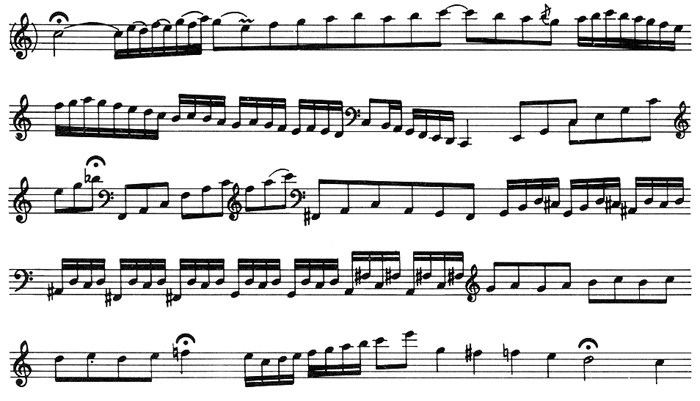
Three cadenzas which employ basset notes of d and c are amended to the clarinet part in handwriting which differs from the solo part. It is possible that Stadler himself added the cadenzas and performed the work while he was in Berlin in an effort to win the public's regard.
During the month of January 1792 a pupil of Mozart, Franz X. Süssmayr, started writing a concerto in D Major for clarinet in A. Two sketches of the first movement are in the British Library (Ex. 2).
Ex. 2. Sketch to a Concerto in D for Clarinet in A by F.X. Süssmayr, page 120 verso of manuscript British Library.

Mozart wrote to Constanze on October 7, 1791, "Do urge Süssmayr to write something for Stadler, for he has begged me very earnestly to see to this."35 The sketches are clearly written for basset clarinet in A but only for the basset notes d and c. As in the Mozart works, the basset notes are often approached and left by leap from different registers, thus substantiating the ease with which Stadler could play the instrument. It appears that Süssmayr never completed the concerto.
On May 5, 1794 the St. Petersburg Gazette advertised a concert to be given on May 9 at the Theater-Kamenny by the "remarkable Viennese clarinetist Anton Stadler," featuring "diverse pieces on a clarinet of his own invention."36 According to the Hannoversch Anzeigen of September 7 and 11, 1795, Stadler gave a concert in the Ballhofe of the London Hotel in Hannover on Saturday evening, September 12. The concert was first scheduled in the smaller Londonschenkensaale for Thursday, September 10, but at the "public's request" was changed to the larger hall. The announcement stated that Stadler would play "on a clarinet of his invention which is distinguished by its softer tone and range of four full octaves. . . . a concerto and eight variations on his invented clarinet."37 It is worthy of note that the program of 1788 introducing this instrument also lists a performance of a concerto and variations. Unfortunately, a program for the later concert has not been located.
According to the Staatliche-Schematismus of Vienna, Stadler returned to the orchestra in 1795 and played until 1797 when his brother Johann assumed the principal chair. Johann kept that position until his death in 1804. Anton did play again in the orchestra during the years 1807-1808. According to Köchel he was pensioned in 1799 at full salary and continued to play in the opera orchestra.38
Not until 1801 do more detailed descriptions of the basset clarinet appear. According to the Journal des Luxus und der Moden, October 1801, Stadler performed at the Augarten. His instrument "did not, as is usual, run straight down to the opening of the bell, but was fitted with a transverse pipe that constituted the lower fourth of the instrument. From this pipe, the bell projected even further outward. The advantage of this modification is that the instrument gains more depth by this means, but sounds like the French horn in the low tones." The description resembles the Kasten of the basset horn, a box containing three vertical tubes that serve to lengthen the basset horn and yet make the added length manageable. It is unlikely that the reviewer would mistake this for a basset horn. Actually the added piece seems to have been a horizontal pipe, and one fourth the size of the instrument. The lower section seems also to bend outward.39
By 1803 Franz Scholl advertised in an issue of the Kaiserliche Wiener Zeitung "his newly designed and considerably improved wind instruments, a portion of which are of his own invention. (1) His clarinet (in B-flat or C) extended two tones lower, that is to low C, which since one has the tonic note for cadences, always produce a good effect. . . . Scholl has received a patent on his inventions from his Imperial Majesty the Kaiser." This advertisement not only creates more confusion as to the inventor of the basset clarinet, but also informs us that basset clarinets were available to other clarinetists besides Stadler and also pitched in the key of C. Other works also must have been written for basset clarinet in both B-flat and C.40
Performances of December 23, 1805 and March 31, 1806 at the court theater included "an aria by Paer sung by Madame Campi, accompanied by Stadler on a clarinet with modifications of his own invention" (Fig. 4).
Figure 4.
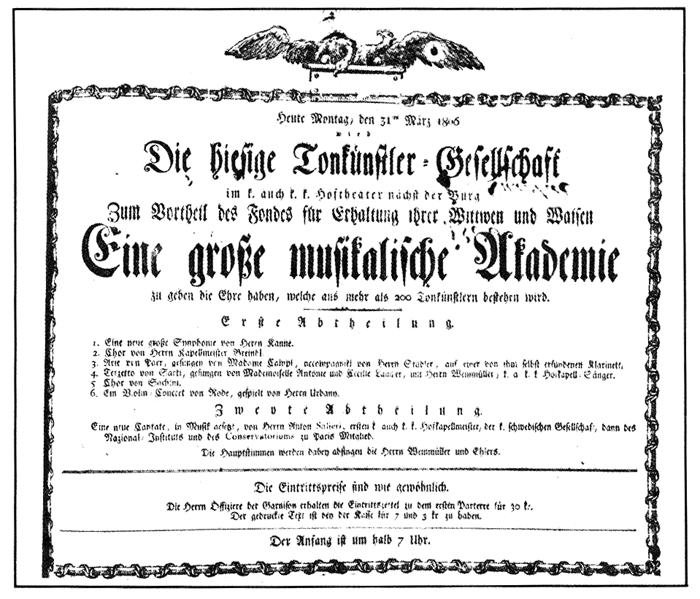
Several concert arias by Paer with obbligato instrument are listed in the Hofmeister-Whistling catalogs; none feature clarinet. The aria may have been taken from one of Paer's operas written in Vienna.41
A clarinet method by J.G.H. Backofen published around 1803 informs the reader,
Another more recent and excellent invention is this, that clarinets with d and c are now being made in Vienna. This makes the clarinet so much better, because it now besides the great advantage it gets through low c, which until now it missed so much in its favorite key of C, has three full octaves, in which every clarinetist can play easily. . . . For now, I will skip the great advantages of the preceding and of this new invention, in order to talk about these clarinets in more detail when they come into normal use.42
Unfortunately, Backofen does not refer to these clarinets in his later publications. It is noteworthy that he does expect the clarinets to become widespread.
Reports of Stadler's clarinet continued to be made after his death in 1812. A second more detailed description was made in 1834 by Wilhelm Schneider in the Historische-Technische Beschreibung der musikalischen Instrumente. (Many music dictionaries between 1802 and 1878 mention Stadler's clarinet and the added keys but do not increase our knowledge of the instrument.) He writes:
In 1801, Stadler, royal musician in Vienna, made certain modifications to his clarinet at its lower end; namely he lengthened and bent the mouth of the bell sideways where he drilled four holes, namely d-sharp, d, c-sharp, and c. It appears, however, that this invention was not very widespread, since one sees few such instruments.43
From this description it seems that the bell itself was lengthened and the tone holes located directly on the bell. The bell projected to the side instead of forward as in some basset horns.
A third detailed description appears in 1835 in the Musikalische Tonwerkzeuge written by Heinrich Welcher.
The court musician, Stadler, in Vienna, lengthened (around 1790) the instrument (clarinet) and bent it somewhat sideways at the bell, in the same way as the bent flute of Midas. Although within this larger format, the four low notes of d-sharp, c [sic], c-sharp, c, were gained, this type did not find any widespread use.44
Because of the lack of both precise descriptions and extant examples of eighteenth-century basset clarinets, it is difficult to determine the instrument's appearance. The descriptions given of a longer clarinet with a "transverse pipe," a projecting bell and additional keywork apply equally well to the basset horn. As royal instrument maker, Lotz made clarinets, basset horns and other wind instruments. Perhaps his basset clarinet was modeled in part on the basset horn. A closer inspection of basset horns in general and Lotz's instruments more specifically (their dimensions, pitch, etc.) may reveal basset clarinets previously designated as basset horns.45
Several clarinetists of this century (Murt Birsak, Berhard Kroll, Hans Deinzer, Alan Hacker, Milan Kostoryhz, Jiri Kratochvil, W. Rey, David Satz, and Hans Rudolf Stadler) have commissioned the building of special lower joints in order to perform more authentic versions of the Mozart clarinet concerto. A reconstructed version of the concerto by Jiri Kratochvil appears in the Neue Mozart Ausgabe. Recordings of the reconstructed concerto are also available, for example Hans Stadler on Musica Mundi, VMS 807, and Hans Deinzer on Harmonia mundi, BASF, Stereo 20 21798-1.
Philip Bate recently discovered a nineteenth-century basset clarinet on a barrow in a London street market (Fig. 5).
Figure 5.
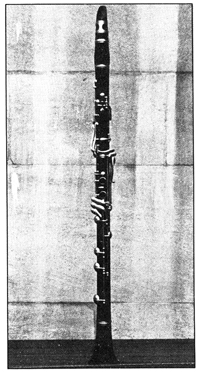
The basset clarinet in B-flat has added keywork for small d and c, manipulated by the little fingers of both hands. Anthony Baines believes the instrument to be of French origin and that it was probably used to perform La Clemenza di Tito. It is to be hoped that further research will reveal additional compositions for the basset clarinet, as well as eighteenth-century examples of the instrument.
1This article is based on a paper given at the national meeting of the American Musicological Society held in New York City in November 1979. I wish to express my thanks to Philip Bate; Anthony Baines, Oxford University; Karl-Heinz Köhler, Deutsche Staatsbibliothek; Hedwing Mittringer, Gesellschaft der Musikfreunde; Heinrich Sievers, Hannover; Irmgard Taylor, State University of New York at Cortland; and Volker von Volckamer, Wallerstein'sche Bibliothek und Kunstsammlung.
2Program of February 20, 1780, K.K. National Hoftheater secured from the Österreichische Nationalbibliothek, Vienna; Hannoversche Anzeigen, No. 72 (September 7, 1795) and No. 73 (September 11, 1795).
3Ernst Hess, "Die ursprüngliche Gestalt des Klarinetten Konzertes KV 622," Mozart Jahrbuch (1967), pp. 18-30; Jiri Kratochvil, "Ist die heute gebrauchliche Fassung des Klarinetten Konzerts und des Klarinetten Quintetts authentisch?" Beiträge zur Musikwissenschaft (1960), pp. 27-43.
4Karl Maria Pisarowitz, "'Müasst ma nix in übel aufnehma' Betragversuch zu einer Gebrüder-Stadler-Biographie," Mitteilungen der Internationalen Stiftung Mozarteum (February 1971), pp. 29-33; hereafter cited as Pisarowitz.
5Bertruch, "Wiener Kunstnachrichten," Journal des Luxus und der Moden XVI (October 1801), 543-544; hereafter cited as Bertruch.
6A letter of one of the Stadler brothers to Ignatz von Beecke, Hauptmann for the Orchestra at Wallerstein, November 6, 1781, Fürstlich Oettingen-Wallerstein'sche Bibliothek und Kunstsammlung.
7Program of March 21, 1773, Kärtnertortheater, Gesellschaft der Musikfreunde, Vienna.
8Daniel N. Leeson and David Whitwell, "Mozart's 'Spurious' Wind Octets, Music and Letters LIII (October 1972), 378.
9Program of March 14, 1780, Kärtnertortheater, Tonkünstler-Societät, Gesellschaft der Musikfreunde, Vienna.
10Pisarowitz, p. 30.
11Karl Ferdinand Pohl, Denkschrift aus Anlass des hundertjährigen Bestehens der Tonkünstler-Societät (Vienna, 1871), p. 91.
12Pisarowitz, p. 30.
13To my knowledge this is the only letter by either Stadler brother. The text, translated from the German, is as follows:
The consideration which your Eminence was kind enough to show during your stay in Vienna encourages us to take the liberty to request in this letter something on which our future happiness may depend. We have been informed that in Wallerstein a good bassoonist is wanted, that the whole Palfysche Music has resigned, and that Griesbacher, who was first [bassoonist] there will come up with pleasure if he is acceptable to you. Otherwise the two horn players know him well, and you could also inquire of your local friends about his morals.
As far as we two brothers are concerned, we are also willing to fill the clarinetists' position, if it is still open. We also play basset horn with Mr. Griesbacher in trios, also in duets on clarinet, and each of us alone in concertos, and we can also put together octets on clarinet and oboes, or basset horn and oboes in various combinations that make quite a good effect. In a pinch you can use us instead of oboes, and [we] can also play a little violin and viol [viola]. Should one or the other proposals be acceptable, we ask your Excellency to have a little talk with the most gracious Countess of Thun, who is also favorably inclined toward us, in order to tell about this matter more fully—for Which kindness we are waiting with all possible respect.
14Pisarowitz, p. 30.
15Ernst Ludwig Gerber, Historisch-Biographisches Lexikon der Tonkünstler, 2 vols. (Leipzig: Breitkopf, 1790-92), s.v. "Stadler"; hereafter cited as Gerber. The Staatliche-Schematismus-1788, Österreichische Nationalbibliothek lists five clarinetists, including Anton (first) and Johann (second).
16Otto E. Deutsch, Mozart: A Documentary Biography, trans. Eric Blom, Peter Branscombe and Jeremy Noble (Palo Alto: Stanford University Press, 1966), pp. 256-257; hereafter cited as Deutsch.
17Emily Anderson, The Letters of Mozart and His Family, 2nd ed., prepared by A. Hyatt King and Monica Carolan (New York: St. Martin's Press, 1966), II, 638; hereafter cited as Anderson.
18Joseph Saam, Das Bassetthorn, seine Erfindung und Weiterbildung (Mainz: B. Schotts Söhne, 1971), pp. 37-38; J. Geoffrey Rendall, The Clarinet (New York: Norton, 1971), pp 128-129; Lyndesay G. Langwill, An Index of Musical Wind Instrument Makers, 6th ed. (Edinburgh: the author, 1980), p. 110.
19Program of February 20, 1788, National Hoftheater, Österreichsche Nationalbibliothek, Vienna.
20Johann Georg Heinrich Backofen, Anweisung zur Klarinette, nebst einer kurzen Abhandlung über das Basset-Horn (Leipzig: Breitkopf und Härtel, c. 1803), p. 3; hereafter cited as Backofen.
21W.A. Mozart, ergänzt von Robert D. Levin, Allegro in B zu einem Quintette für Klarinette, zwei Violinen, Viola, und Violoncello, KV Anh. 91 (516c), Fragment (Kassel: Nagels Verlag, 1970).
22Housed at the International Stiftung Mozarteum, Salzburg.
23The passage could easily have been written in treble clef, suggesting that perhaps Mozart was teasing Stadler, as he had done with Joseph Leutgeb, for whom he wrote the horn concertos.
24In the first edition of Così fan tutte some of the basset notes still appear; others are written an octave higher.
25Gerber, loc. cit.
26Housed at the Staatsbibliothek Preussisches Kulturbesitz, Musikabteilung, Mendelssohn Archiv, Berlin.
27Anderson, pp. 966-967.
28Anderson, p. 967.
29Rudolph Procházka, Mozart in Prag (Prague: Dominiens, 1892), p. 174, n. 47.
30Georg Nikolaus von Nissen, Biographie W.A. Mozarts [etc.] (Leipzig: Breitkopf und Härtel, 1828), p. 684.
31Paul Nettl, Mozart and Masonry (New York: Da Capo Press, 1970, reprint of original 1957 edition), p. 21.
32"Recension," Allgemeine musikalische Zeitung IV (March 1802), 411-413. See also Arthur J. Ness, Some Remarks Concerning the Basset Clarinet and Mozart's Concerto in A Major (K.V. 622), (unpublished master's thesis, Harvard University, 1961), p. 80.
33Johann F. Reichardt and F. Ae. Munzen, ed., Musikalisches Wochenblatt (Berlin: In der neuen Berlinschen Musikhandlung, 1793), p. 41.
34Deutsch, p. 223.
35Emily Anderson, The Letters of Mozart and His Family (London: MacMillan, 1938), III, 1438.
36Robert Mooser, Annales de la musique et des musiciens en Russie au XVIIIe siècle (Geneva: Mont Blanc, 1948-52), II, 613.
37Staatliche-Schematismus, 1770-1812, Österreichische Nationalbibliothek; Ludwig Ritter von Köchel, Die kaiserliche Hof-Musikkapelle in Wien von 1542 bis 1867 (Vienna: Beck und Holder, 1869), pp. 90-91.
38Hannoversche Anzeigen, No. 72 (September 7, 1795) and No. 73 (September 11, 1795).
39Bertruch, pp. 543-544.
40Kaiserliche Wiener Zeitung, April 2, 1803.
41Programs of December 23, 1805 and March 31, 1806, K.K. Hoftheater, Gesellschaft der Musikfreunde.
42Backofen, p. 35.
43Wilhelm Schneider, Historisch-Technische Beschreibung der musikalischen Instrumente (Neisze und Leipzig: T. Hennings, 1834), XII, 28. For further historical background see Pamela L. Poulin, The Basset Clarinet of Anton Stadler and its Music (unpublished master's thesis, Eastman School of Music, 1977).
44Heinrich Welcher von Gontershauen, Musikalische Tonwerkzeuge (Frankfurt-am-Main: Im selbst Verlag des Verfassers, 1855), s.v. "Clarinette."
45More detailed information is contained in Poulin, op. cit.


